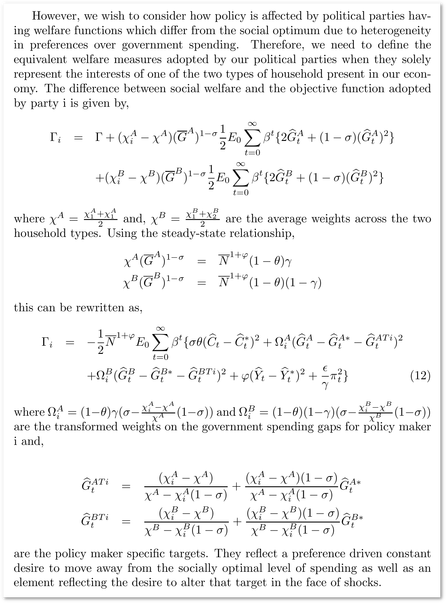New Keynesians use mathematics to ‘prove’ some very odd stuff … Take, for example, a paper by Campbell Leith and Simon Wren-Lewis entitled Electoral Uncertainty and the Deficit Bias in a New Keynesian Economy. The thrust of the paper is that our particular form of party-based democracy naturally leads to ‘deficit bias’ … The authors identify the root problem to be one of ‘heterogeneity’ — the fact that different political parties will have different views about how to run the country. Let’s look at a snippet from the paper to see how they use maths to support this earth-shattering discovery: This lays bare a fundamental problem with the New Keynesians. Their model reduces the economy — the complexity of which is beyond the limits of human understanding — to a ridiculously
Topics:
Lars Pålsson Syll considers the following as important: Economics
This could be interesting, too:
Lars Pålsson Syll writes Schuldenbremse bye bye
Lars Pålsson Syll writes What’s wrong with economics — a primer
Lars Pålsson Syll writes Krigskeynesianismens återkomst
Lars Pålsson Syll writes Finding Eigenvalues and Eigenvectors (student stuff)
New Keynesians use mathematics to ‘prove’ some very odd stuff … Take, for example, a paper by Campbell Leith and Simon Wren-Lewis entitled Electoral Uncertainty and the Deficit Bias in a New Keynesian Economy. The thrust of the paper is that our particular form of party-based democracy naturally leads to ‘deficit bias’ … The authors identify the root problem to be one of ‘heterogeneity’ — the fact that different political parties will have different views about how to run the country. Let’s look at a snippet from the paper to see how they use maths to support this earth-shattering discovery:
This lays bare a fundamental problem with the New Keynesians. Their model reduces the economy — the complexity of which is beyond the limits of human understanding — to a ridiculously simple model which bears no relation to reality. They then selectively prime the model with whatever data provides the desired answer. In this case they have defined a model economy with only two household types and then assume that a political party will ‘solely represent’ the interest of one of them. Is that really what politicians do?
The Leith & Wren-Lewis paper is nothing but nonsense on stilts. And worse still — this kind of math-wanking is supposed to be taken seriously!
‘New Keynesian’ economists would be wise to — at least once — read what Keynes himself had to say about the kind of nonsense-methodology they are using:
But I am unfamiliar with the methods involved and it may be that my impression that nothing emerges at the end which has not been introduced expressly or tacitly at the beginning is quite wrong … It seems to me essential in an article of this sort to put in the fullest and most explicit manner at the beginning the assumptions which are made and the methods by which the [results] are derived; and then to state at the end what substantially novel conclusions have been arrived at …
I cannot persuade myself that this sort of treatment of economic theory has anything significant to contribute. I suspect it of being nothing better than a contraption proceeding from premises which are not stated with precision to conclusions which have no clear application … [This creates] a mass of symbolism which covers up all kinds of unstated special assumptions.
Letter from Keynes to Frisch 28 November 1935

